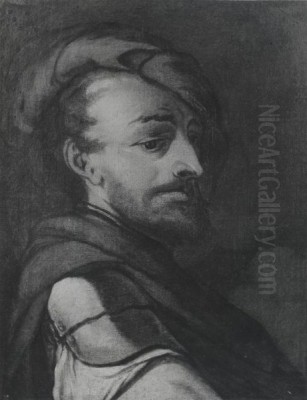
Giulio Carpioni stands as a significant figure in the landscape of early Baroque art in Italy. Active primarily during the 17th century, he navigated the rich artistic currents of his time, forging a distinct style that blended the traditions of his native Venice with emerging trends from other Italian centers and beyond. As both a painter and a skilled etcher, Carpioni contributed a diverse body of work, exploring religious narratives, mythological scenes, and the vibrant energy of contemporary life through his unique artistic lens. His career, largely centered in the Veneto region, particularly Vicenza, marks him as a key provincial master whose work reflects both his training and his individual creative spirit.
Early Life and Venetian Formation
Born likely in Venice around 1613, Giulio Carpioni's artistic journey began in one of Italy's most vibrant artistic hubs. The precise details of his earliest years remain somewhat obscure, but it is well-documented that by 1630, he had entered the workshop of Alessandro Varotari, more famously known as Il Padovanino. This apprenticeship was crucial, placing the young Carpioni directly in line with the powerful legacy of the Venetian High Renaissance.
Varotari himself was deeply indebted to the style of Titian, the towering figure of 16th-century Venetian painting. Through his master, Carpioni absorbed the fundamental principles of Venetian colorito – the emphasis on rich color, atmospheric effects, and the expressive potential of light and shadow. This grounding in the Venetian tradition would remain a constant, albeit evolving, element throughout his career, providing a foundation upon which other influences would build.
Formative Influences: Caravaggisti and Beyond
While the workshop of Varotari provided a strong link to the Venetian past, Carpioni's artistic sensibilities were also shaped by more contemporary forces. The early 17th century saw the pervasive influence of Caravaggio and his followers, the Caravaggisti, whose dramatic realism and use of chiaroscuro (strong contrasts between light and dark) revolutionized painting. Carpioni appears to have been receptive to these trends.
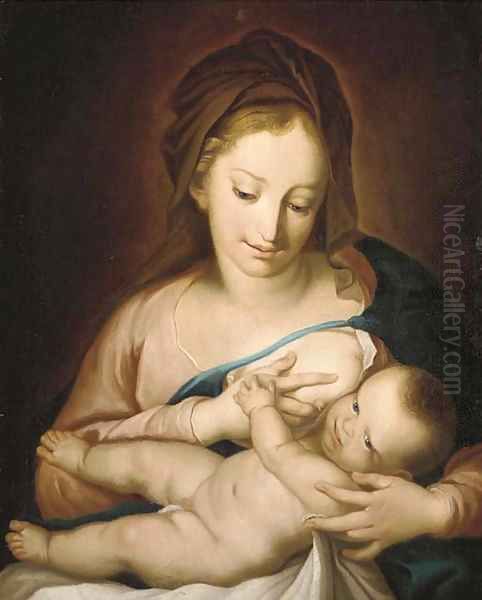
Sources indicate the influence of artists like Carlo Saraceni, a Venetian who spent significant time in Rome and adopted a Caravaggesque style, and Jean Leclerc, a painter from Lorraine who also worked in Venice and Rome and was associated with Saraceni. Their work likely exposed Carpioni to a more naturalistic approach to depicting figures and a heightened sense of drama, moving beyond the idealized beauty often associated with the High Renaissance. The influence of Simone Cantarini, a Bolognese painter and etcher associated with Guido Reni but also known for his naturalism, and Nicolas Régnier, a Flemish painter active in Venice who blended Caravaggism with Bolognese classicism, are also cited as contributing factors to Carpioni's developing style.
Broadening Horizons: The Lombard Connection
A significant moment in Carpioni's early development occurred in 1631 when he traveled with his master, Varotari, to Bergamo. This journey exposed him to the artistic traditions of Lombardy. Lombard art, particularly in the wake of painters like Moretto da Brescia and Giovanni Battista Moroni from the previous century, often possessed a distinct strain of realism and a focus on careful observation, sometimes differing in character from the more painterly and atmospheric approach dominant in Venice.
This encounter with Lombard art seems to have resonated with Carpioni. It likely reinforced the tendencies towards realism he may have already absorbed from the Caravaggisti, perhaps offering a different model for achieving naturalistic effects and detailed rendering. This experience added another layer to his artistic vocabulary, contributing to the complex synthesis that would characterize his mature work. The Lombard influence provided a counterpoint to the purely Venetian aesthetic, encouraging a greater degree of objective representation.
Vicenza: A Center of Mature Production
Around 1638, Giulio Carpioni made a pivotal decision, relocating from Venice and settling in Vicenza. This city, located on the Venetian mainland (Terraferma), would become his primary base for the remainder of his long and productive career. While perhaps not possessing the same international artistic draw as Venice, Vicenza offered opportunities for patronage and allowed Carpioni to establish himself as a leading local figure.
In Vicenza, Carpioni developed a close professional relationship with Francesco Maffei, another significant painter active in the city, particularly after Maffei's own move there around 1657. Maffei was known for a particularly dynamic and expressive style, characterized by loose, almost flamboyant brushwork and dramatic compositions. The interaction between the two artists appears to have been mutually influential, with Carpioni potentially absorbing some of Maffei's energy and freedom, especially evident in his mythological and bacchanalian subjects. Carpioni's presence significantly enriched the artistic scene in Vicenza during the mid-17th century.
The Carpioni Style: A Synthesis of Traditions
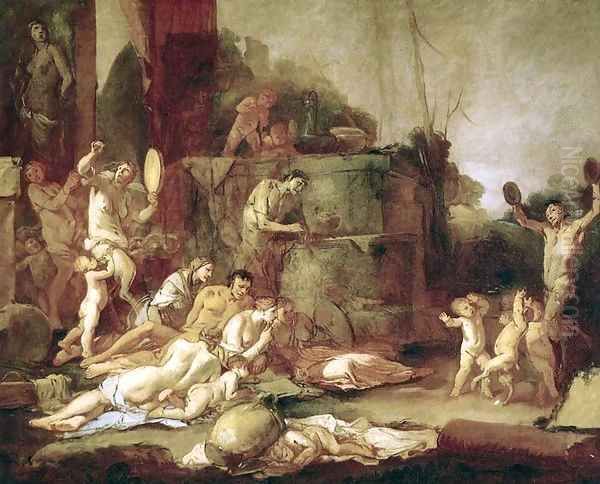
Giulio Carpioni's mature artistic style is best understood as a fusion of the diverse influences he encountered. He retained the Venetian emphasis on color and light, often employing rich palettes and subtle atmospheric effects reminiscent of his training under Varotari and the legacy of Titian and Paolo Veronese. However, this was tempered by the realism and dramatic intensity derived from the Caravaggisti and potentially reinforced by his exposure to Lombard art.
His handling of paint could vary depending on the subject and scale of the work. In some pieces, particularly smaller mythological or bacchanalian scenes, one might see a more fluid, energetic brushstroke, perhaps reflecting Maffei's influence. In larger religious commissions, a more controlled and detailed finish might prevail. He demonstrated considerable skill in rendering textures and capturing the play of light across surfaces. Comparisons have been made to the classicism of Nicolas Poussin, though Carpioni's figures often possess a different sense of proportion, and his color can appear more transparent or luminous than that of the French master working in Rome. His unique blend resulted in works that were both grounded in observation and imbued with Baroque dynamism.
Thematic Focus: Sacred and Profane
Carpioni's oeuvre encompassed the major themes popular during the Baroque period. Religious subjects formed a significant part of his output. He executed altarpieces and smaller devotional paintings for churches and private patrons, primarily within the Veneto region. Works like the Madonna and Child exemplify his ability to handle traditional iconography with sensitivity and skill, often infusing familiar scenes with a gentle humanity. His religious works frequently display the careful composition and emotional resonance expected of Counter-Reformation art.
Alongside sacred themes, Carpioni excelled in depicting mythological and historical subjects. These often provided scope for more dynamic compositions and a focus on the human form in motion. Tales from classical antiquity, such as Hercules and the Giants or the Rape of Europa, allowed him to explore dramatic narratives and potentially more sensuous treatments. He also seems to have had a particular fondness for bacchanals and festival scenes, such as his Bacchanal or Carnival paintings. These works, often featuring lively figures, classical ruins, and an air of revelry, showcased his ability to orchestrate complex, multi-figure compositions filled with energy. Series like the one depicting the story of Leander and Hero further demonstrate his engagement with classical romance and tragedy.
Notable Painted Works
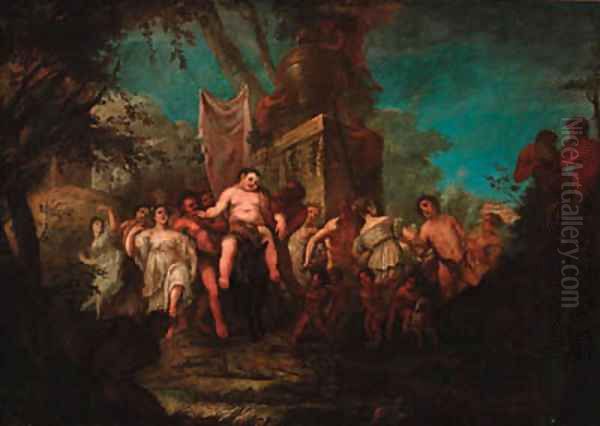
Several key works stand out in Carpioni's painted output. His Martyrdom of Saint Catherine, likely produced during his time in Vicenza, is often cited as one of his most original and powerful religious paintings. It would have showcased his ability to handle a complex narrative involving intense emotion and physical drama, integrating his skills in figure drawing, composition, and the use of light to heighten the scene's impact.
The Triumph of Silenus represents his engagement with mythological subjects often associated with revelry and the followers of Bacchus. Such paintings allowed for a display of anatomical knowledge and dynamic figure arrangement. Furthermore, Carpioni occasionally collaborated with his son, Carlo Carpioni, who also became a painter. Joint works like the Apotheosis of the Dolfin Family and the Allegory of the Grimani Family point to a family workshop dynamic and the execution of prestigious commissions for prominent Venetian families, likely involving complex allegorical programs.
Carpioni the Etcher: Master of the Line
Beyond his considerable achievements as a painter, Giulio Carpioni was also a highly accomplished etcher. Printmaking offered a different medium for artistic expression and allowed for wider dissemination of his compositions. His etchings often echo the themes found in his paintings, including religious scenes, mythological subjects, and allegories. He developed a refined etching technique, characterized by delicate lines, careful tonal gradations achieved through hatching and cross-hatching, and a sensitive handling of light.
His work in this medium shows the influence of other printmaker-painters, notably the Bolognese artist Simone Cantarini (also known as Simone da Pesaro), whose etching style was admired for its freedom and luminosity, and perhaps Odoardo Fialetti, another Bolognese artist active in Venice who was known for his prolific output of prints. Carpioni's own etchings, such as Saint Anthony of Padua, Christ on the Mount of Olives, The Penitent Magdalen, Madonna Reading, and Madonna with the Rosary, demonstrate his mastery. The print The Kingdom of Hypnos (c. 1660), depicting the realm of sleep, is a particularly evocative example of his ability to create atmospheric and imaginative scenes in black and white. His etchings were collected and appreciated, finding their way into major European print rooms.
Later Life, Legacy, and Family
Giulio Carpioni remained active as an artist for decades, solidifying his reputation as one of the leading painters in Vicenza and the surrounding Veneto region. His consistent output and the quality of his work ensured continued patronage. His influence extended through his own works and potentially through students or assistants in his workshop, although details about his teaching activities are scarce.
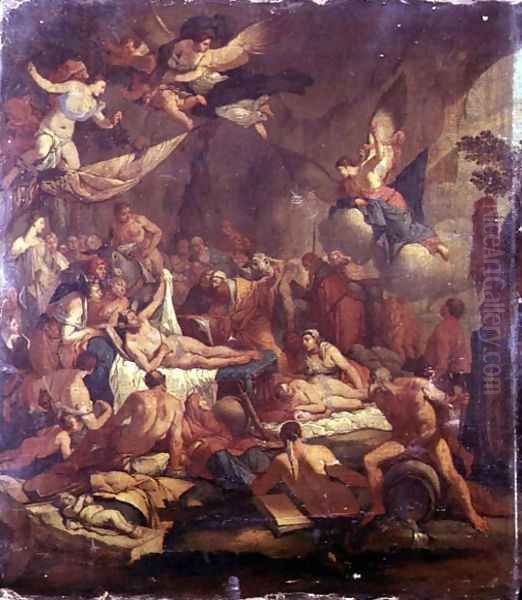
His son, Carlo Carpioni, followed him into the profession, ensuring the continuation of the family name in the art world, at least for another generation. Their collaborations on significant commissions suggest a close working relationship. Giulio Carpioni passed away in 1678 (some sources state 1679), likely in Verona, bringing to a close a long and successful career.
His legacy endured through his numerous paintings and etchings. While perhaps overshadowed on the international stage by the giants of Venetian painting or the major figures of the Roman Baroque, Carpioni holds a secure place in the history of Italian art, particularly within the context of the Veneto. His works are preserved in churches and museums throughout the region, as well as in major international collections, including galleries in Vienna, Munich, Augsburg, Dresden, and Florence. The mention of works held in private collections in England also attests to his appeal beyond Italy.
Conclusion: A Distinct Voice in the Venetian Baroque
Giulio Carpioni represents a fascinating case study in the artistic landscape of 17th-century Italy. Rooted in the rich coloristic tradition of Venice through his training with Varotari, he actively engaged with the dramatic realism of the Caravaggisti and the observational focus of Lombard art. His long career, centered in Vicenza, saw him synthesize these diverse elements into a personal style characterized by skilled composition, sensitivity to light and color, and an ability to tackle a wide range of subjects, from profound religious narratives to exuberant mythological scenes and bacchanals. As both a painter and a distinguished etcher, Carpioni made a lasting contribution, enriching the artistic heritage of the Veneto and leaving behind a body of work that continues to be appreciated for its technical skill and expressive power. He remains a testament to the vitality and diversity of Baroque art as it flourished beyond the major metropolitan centers.